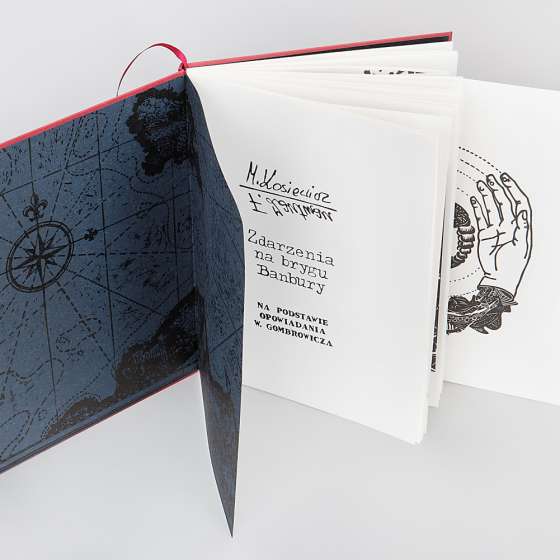Akademia Sztuk Pięknych w Łodzi

Autor: Marta Kosiewicz
Akademia Sztuk Pięknych w Łodzi
Marta Kosiewicz
Kierunek studiów: Malarstwo
Tytuł pracy: Dziennik podróży – ilustracje do opowiadania Witolda Gombrowicza pt. „Zdarzenia na brygu Banbury”
Promotor: prof. dr hab. Gabriel Kołat
Absolwentka Wydziału Grafiki i Malarstwa Akademii Sztuk Pięknych w Łodzi oraz Filologii polskiej na Uniwersytecie Łódzkim. Skupiona na detalu i pracy rzemieślniczej. Łączy ilustrację, eksperymenty typograficzne i grafikę warsztatową w interdyscyplinarnej formie jaką jest książka artystyczna. Inspiruje ją semiotyczna interpretacja literatury, fascynacja językiem i teatrem. Dyplom magisterski zrealizowała we współpracy z Muzeum Książki Artystycznejw Łodzi.
The graduate of the Faculty of Graphics and Painting at the Academy of Fine Arts in Łódź and Polish Philology at the University of Łódź. Focused on detail and craft work, she combines illustration, typographic experiments and graphic arts in an interdisciplinary form which is an art book. Inspired by the semiotic interpretation of literature, at the same time passionate about language and theatre. She completed her master's degree in cooperation with the Book Art Museum in Łódź.
Dziennik podróży – ilustracje do opowiadania Witolda Gombrowicza pt. „Zdarzenia na brygu Banbury”
Ilustracje do Zdarzeń Witolda Gombrowicza stanowią integralną całość z ręcznie złożonym w Muzeum Książki Artystycznej tekstem. Opowiadanie fascynuje głęboką analizą psychologiczną człowieka. Pierwszoosobowa narracja satyrycznie odwołuje się do oświeceniowego pamiętnikarstwa, poetyka zaś obfituje w absurdi aluzje homoerotyczne. Czarne linoryty nie ilustrując dosłownie wypadków, wnoszą nowy ładunek emocjonalny. W ich teatralności kryją się szarady, groteskowe pary, antonimy, oraz dodatkowe artefakty takie jak rozkładana mapa czy ręczne dopiski tuszem. Całość zamyka autorska, stylizowana oprawa.
The illustrations for Witold Gombrowicz's Events constitute an integral whole with the text hand-assembled at the Art Book Museum. The story fascinates with a deep psychological analysis of a human being. The first-person narrative satirically refers to the diary writing of the Enlightenment, while the poetics abound in absurdity and homoerotic allusions. Although black linocuts do not literally illustrate the events, they bring a new emotional charge. Their theatricality conceals charades, grotesque pairs, antonyms, and additional artifacts such as a folded map or handwritten notes in ink. The whole is closed with an original, stylized binding.







